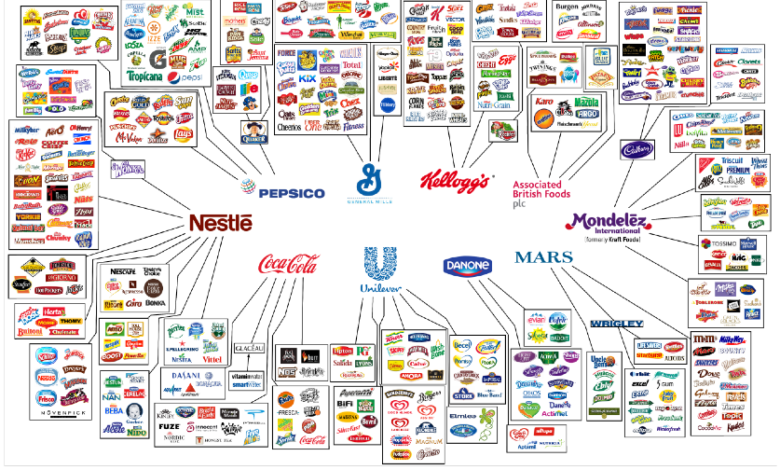The food oligopoly: companies that monopolize what you consume every day

Do the exercise and try to identify how many of these brands you use in your day to day from the moment you wake up until you go to sleep. Acts such as brushing your teeth, shaving, showering, dressing, applying deodorant, eating cereals, eating at a fast food restaurant, feeding your dog or cat, chewing gum or having a soda involve consuming some of the products traded by only a few corporations. Our economy is based on consumption, and this consumption is defined and conditioned by a handful of companies.
The 10 companies that control (almost) everything you consume daily, produce and distribute more than 2,150 daily consumer products in dozens of countries around the world and bill more than a billion dollars a day for it . Coca Cola, Pepsico, Kelloggs, Nestlé, Johnson & Johnson, P&G, Mars, Kraft, Unilever and General Mills are the 10 corporations that control a large part of the mass consumer market and that focus on this infographic produced by the Convergence Alimentaire website (food convergence). Probably some of the great absent from this infographic are the French group Danone , specialized in dairy products and which markets more than 30 brands of dairy products and waters, and the British Associated British Foods , which markets around a dozen product brands in a total of 44 countries.
Although it may not seem like it, it is more than likely that in your day to day you consume dozens of products from the so-called Big 10, almost without you noticing. Below we break down the total brands and products that each of these giants sells to hundreds of millions of consumers around the world.
Unilever: more than 400 brands.
Coca-Cola: more than 400 brands.
Pepsico: 22 brands (although it distributes products by partnering with other companies).
Mars: more than 100 brands.
Johnson & Johnson: more than 75 brands.
Procter & Gamble: more than 300 brands.
Kraft: more than 150 brands.
Nestlé: 31 brands under which it distributes 146 products.
Kellogg’s: more than 65 brands.
Far from the idea that one may have that the consumer market for daily use food products is supplied by hundreds of companies, this infographic shows us that the reality is not like that. There is no real diversity, since those small brands that wanted to offer something different were already absorbed by the large commercial conglomerates. Mergers and purchases of small companies by large conglomerates such as those presented here are some of the explanations for the phenomenon, which leaves many of the consumer brands in very few hands, and which, according to several organizations, have dangerous consequences due to the power that these conglomerates acquire in the face of political power and its growing capacity for influence. In fact something similar also happens in the world of the media,
The map showing the organization of small product labels and their companies illustrates how a large number of brands give us a false image of freedom of choice. Adam Smith spoke of the invisible hand that controls the market. In this article it can be seen that the domain is held by a small group of entrepreneurs and that the independence felt when choosing a brand of juice or tea and not a soft drink, can take a back seat because they are buying a product of the same company.
The power of the big 10
Worldwide, more than 4,000 cups of Nescafé are drunk per second and Coca-Cola products are consumed 1.7 billion times a day. Three companies control 40 percent of the world cocoa market , and in 2010 Nestlé reported revenues higher than the GDP of Guatemala or Yemen.
In fact, the Big 10 together generate an income of more than 1.1 billion dollars a day and employ millions of people, directly and indirectly, in the cultivation, processing, distribution and sale of their products. Today, these companies are part of an industry valued at $ 7 trillion, larger even than the energy sector , and representing approximately 10 percent of the world economy.
The Big 10 in the eyes of Intermon Oxfam
According to a recent campaign by the Intermon Oxfam (IO) organization, the ten large companies that control the world food market are not respecting some of the basic rights of farming communities that provide them with land, water, labor and raw materials for that they make their products. As a result, the «Big 10» continue to increase their commercial success , billing between them 1,100 million dollars every day, but millions of others, those of small farmers, are getting poorer. In fact, 80% of the hungry people on the planet work in food production in the agricultural sector.
The campaign IO under the name behind the brand, aims to increase transparency and accountability of 10 companies food and beverage most powerful in the world (10 large) according IO are Associated British Foods (ABF ), Coca-Cola, Danone, General Mills, Kellogg, Mars, Mondelez International (formerly known as Kraft Foods), Nestlé, PepsiCo and Unilever in relation to their supply chain. The results can be seen in the table below.
As IO points out in its report: “In Pakistan, rural communities claim that Nestlé bottles and sells high-value groundwater near towns that cannot afford clean water. In 2009, Kraft was accused of purchasing beef from Brazilian suppliers involved in cutting down trees in the Amazon rainforest for livestock to graze. And Coca-Cola is currently facing allegations of child labor in its supply chain in the Philippines. «
According to IO Behind the Brand reveals that in general, the social responsibility and sustainability programs that companies have carried out so far have been specifically designed to, for example, reduce the use of water or train women farmers . However, these programs do not address the root causes of hunger and poverty, because companies do not have adequate policies to guide their supply chain activities.
IO concludes by stating that some of the main shortcomings of company policies are:
• Companies are not sufficiently transparent in relation to their agricultural supply chains, which makes it difficult to verify the veracity of their statements regarding their “sustainability” and “social responsibility”;
• None of the Big 10 have adequate policies to protect local communities from land and water grabbing along their supply chains;
• Businesses are not taking enough action to curb huge greenhouse gas emissions from the agricultural sector; These emissions have caused changes in the climate, which are now having negative consequences for farmers;
• Most companies do not offer smallholders equal access to their supply chains, and none of them have made a commitment to ensure that they receive a fair price for their products;
• Very few of these companies have taken any action to address the exploitation of women small farmers and agricultural workers in their supply chains. Lluis Torrent, The Confidential
WHAT ALTERNATIVES DO WE HAVE TO EAT HEALTHY WITHOUT EXPLOITING PRODUCERS OR SLIMMING NATURAL RESOURCES?
>> At a particular level we can avoid abusive intermediaries who seek to enrich themselves at the expense of the exploitation of the producer by paying ridiculous prices for their crops, and on the other hand, that the consumer pays margins of up to 500%. You already know that if you buy it in a super market, it is safest that these two questions arise … That is why it is important to buy as much as possible from the local organic farmer and in local markets .
>> We can also buy through a Consumer Group , which are people who come together to buy wholesale from organic and local producers to obtain beneficial prices for producers and consumers. Consumption groups can have a multitude of objectives and functions: some «simply» join together to buy, others, however, have a very close relationship with the producers and organize in advance what predilections they have for the farmer to plant a new product. another vegetable, others organize meetings, workshops, conferences, etc. to publicize responsible forms of consumption and a long etcetera.
>> Ecological and local consumption has a highly positive economic and social return. In addition to generating ties based on respect and ecology among the people who practice it, it means an increase and improvement of jobs based on sustainable and lasting practices.

![Photo of How to Plant Chufa: Planting Method in a [Complete Guide]](https://www.complete-gardening.com/wp-content/uploads/2022/08/how-to-plant-chufa-planting-method-in-a-complete-guide-390x220.jpg)

![Photo of Common Jasmine Cuttings: [Grafts, Time, Rooting and Planting]](https://www.complete-gardening.com/wp-content/uploads/2022/08/common-jasmine-cuttings-grafts-time-rooting-and-planting-390x220.jpg)
